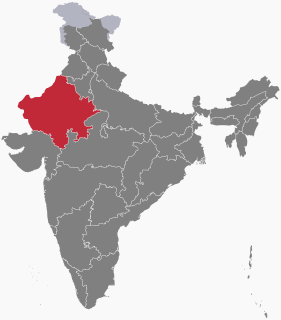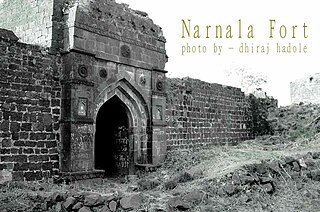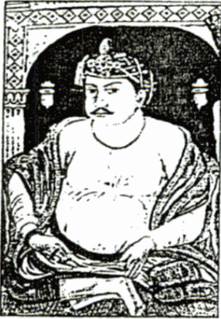Related Research Articles
Gondwana is a region of India, named after the Gondi people who live there. The name of the ancient continent of Gondwanaland was derived from Gondwana, because some of the earliest rock formations of this continent were first investigated in part of the region, in modern Odisha.

The Gondi (Gōndi) or Gond or Koitur are a Dravidian ethno-linguistic group. They are one of the largest groups in India. They are spread over the states of Madhya Pradesh, Maharashtra, Chhattisgarh, Uttar Pradesh, Telangana, Andhra Pradesh, Bihar and Odisha. They are listed as a Scheduled Tribe for the purpose of India's system of reservation. The Gond have formed many kingdoms of historical significance.

Sangram Singh I, popularly known as Rana Sanga or Maharana Sanga, was an Indian ruler from the Sisodia dynasty. He ruled Mewar, the traditional territory of Guhilas (Sisodias) in present-day north-western India. However, through his capable rule his kingdom turned into one of the greatest power of Northern India in early sixteenth century. He controlled parts of present-day Rajasthan, Gujarat, Madhya Pradesh and Uttar Pradesh with capital at Chittor. His reign was admired by several of contemporaries including Babur, who described him the "greatest Indian king" of that time along with Krishnadevaraya of South India. The Mughal historian Al-Badayuni called Sanga as the bravest of all Rajputs along with Prithviraj Chauhan. Rana Sanga was the last independent Hindu king of Northern India to control a significant territory before the Mughal Era. In some contemporary texts is described as the Hindu Emperor in Northern India.
Mandla is a city with municipality in Mandla district in the Indian state of Madhya Pradesh. It is the administrative headquarters of Mandla District. The city is situated in a loop of the Narmada River, which surrounds it on three sides, and for 15 miles between Mandla and Ramnagar, Madhya Pradesh the river flows in a deep bed unbroken by rocks. The Narmada is worshiped here, and many ghats have been constructed on the banks of the river. It was a capital of the Gondwana Kingdom who built a palace and a fort, which in the absence of proper care have gone to ruins.

The Chandelas of Jejakabhukti was an Indian dynasty in Central India. The Chandelas ruled much of the Bundelkhand region between the 9th and the 13th centuries. They belonged to the Chandel clan of the Rajputs.

The Kachhwaha is a Rajput clan found primarily in India. Sometimes families within the clan ruled a number of kingdoms and princely states, such as Jaipur, Bihar, Uttar Pradesh, Madhya Pradesh, Alwar and Maihar.

The history of human settlement in the west Indian state of Rajasthan dates back to about 5,000 years ago. This region was inhabited during great floods after the ice age as well. This area was known as Matsya kingdom. It was the site of the Indus Valley Civilization. The early medieval period saw the rise of many Rajput kingdoms like Pratihars, Chauhans of Ajmer, Guhilot and Sisodias of Mewar, Shekhawats of Shekhawati Sikar, Rathores of Marwar.
Narsingh Rai was a fourteenth-century ruler of the Gond in central India. He was the king of Kherla, succeeding a Rajput ruler called Jaitpal. He was defeated by Firuz Shah Bahmani and later Kherla was restored to him. A daughter of Narsing Rai was also married to Firuz Shah Bahmani.

Narnala Fort or Narnala Killa Sarkar, also known as Shahnoor Fort, is a hill fortress in the Satpura Range of Vidarbh, Maharashtra, India, named after the Rajput Solanki Chaulukya Ruler, Raja Narnal Singh, also known as Narnal Singh Swami. It was renamed as "Shahnoor" by Islamic rulers but again acquired, rebuilt and got its name "Narnala" by ruler RaoRana Narnal Singh Solanki, who migrated from Rajasthan, Tonk district, originally by Patan, Gujarat and was a descendant of Narnal Singh Swami.

The history of the Indian state Madhya Pradesh is divided into three periods - the ancient period, the medieval period and modern period.
Sangram Shah was a king of the Garha Kingdom of Gondwana, in the state of Madhya Pradesh, India. Sangram Shah, who belonged to the Gond Dynasty in central India, was the 48th and most well known ruler of the dynasty, and during his reign he had conquered 52 forts to strengthen his kingdom. The Chouragarh Fort in Narsinghpur was built in his honour for conquering 52 forts.
Ajanbahu Jatbasha is considered by historians to be founder of the Gond dynasty of Chhindwara and Nagpur, which ruled the present days territories of Madhya Pradesh, Chhattisgarh and part of Maharashtra in the 16th-18th centuries. Documentation of his origins and rise to power have not survived, but he is the first historical leader of the mountain Gondi people.

Bakht Buland Shah was a ruler of the Rajgond dynasty. He added to his kingdom, the territories of Chanda and Mandla, and portions of Nagpur, Balaghat, Seoni, Bhandara and the adjoining Rajput kingdom of Kherla/Khedla. The present districts of Chhindwara and Betul also fell under his control. A great warrior, he went on to conquer Pauni, Dongartal, Sivni & Katangi.

Makrai State was a princely state in India during the time of the British Raj. The seat was in Makrai.

The Kachchhapaghatas were a Rajput dynasty that ruled between 10th and 12th centuries. Their territory included north-western parts of Central India ., The Kachhwaha Rajput's of Amber were from the same family of Kachchhapaghat Rajput's.
Hammira-Varman was a king of the Chandela dynasty of central India. He ruled in the Jejakabhukti region. During his reign, the Delhi Sultan Alauddin Khalji conquered some parts of the Chandela kingdom.

The Chahamanas of Shakambhari, colloquially known as the Chauhans of Sambhar or Chauhans of Ajmer, were a dynasty that ruled parts of the present-day Rajasthan and neighbouring areas in India, between the 6th and 12th centuries. The territory ruled by them was known as Sapadalaksha. They were the most prominent ruling family of the Chahamana (Chauhan) Rajput clan.
Gondwana Kingdom was the ruling kingdom in Gondwana region of India. The Gondwana region includes core region of eastern part of the Vidarbha of Maharashtra, Garha Kingdom the parts of Madhya Pradesh immediately to the north of it, and parts of the west of Chhattisgarh. The wider region extends beyond these, also including parts of northern Telangana, western Odisha and southern Uttar Pradesh.
The Garha Kingdom, also called Garha Mandla or Garha Katanga was northern part of Gondwana.

The Gonds of Deogarh were a Gond royal house that founded and ruled the Nagpur Kingdom before being practically being made state pensionaries by the Bhonsle Maratha leader Raghoji I Bhonsle. They made Nagpur a prosperous and plentiful kingdom, founding the city of Nagpur and building further infrastructure. However, internal bickering led to their downfall.
References
- 1 2 Pradesh (India), Madhya (1971). Madhya Pradesh District Gazetteers: Jabalpur. Government Central Press.
- 1 2 3 Chatterton, Eyre (8 January 2021). The Story Of Gondwana. Read Books Ltd. ISBN 978-1-5287-6963-1.